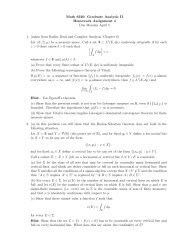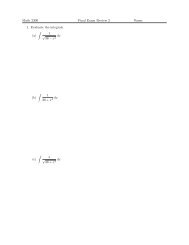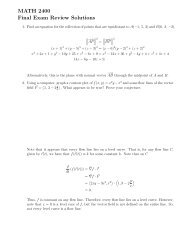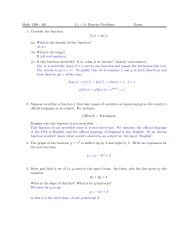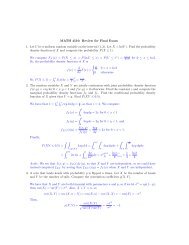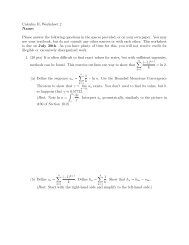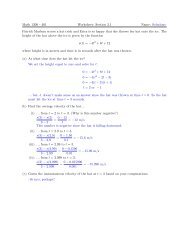Math 1300 4.2 Optimization, part 2 Name: Solutions 1. Consider the ...
Math 1300 4.2 Optimization, part 2 Name: Solutions 1. Consider the ...
Math 1300 4.2 Optimization, part 2 Name: Solutions 1. Consider the ...
You also want an ePaper? Increase the reach of your titles
YUMPU automatically turns print PDFs into web optimized ePapers that Google loves.
<strong>Math</strong> <strong>1300</strong> <strong>4.2</strong> <strong>Optimization</strong>, <strong>part</strong> 2 <strong>Name</strong>: <strong>Solutions</strong>4. <strong>Consider</strong> <strong>the</strong> function f(x) = xe −x .(a) Find <strong>the</strong> global maximum and minimum values of f(x) on [0, 2].f ′ (x) = e −x − xe −x = (1 − x)e −x so our only critical point is at x = <strong>1.</strong>f(1) = 1e −1 = 1/e ≈ 0.368 f(0) = 0e −0 = 0 · 1 = 0 f(2) = 2e −2 = 2 e 2 ≈ 0.271So f has a global max value of 1/e at x = 1 and a global min value of 0 at x = 0.(b) Find <strong>the</strong> global maximum and minimum values of f(x) on (0, ∞).Again our critical point is just at x = 1 and f(1) = 1e −1 = 1/e ≈ 0.368.lim f(x) = f(0) = 0x→0xlim f(x) = lim = 0 since exponential growth dominates linear growth.x→∞ x→∞ ex So f has a global max value of 1/e at x = 1 but no global min.



